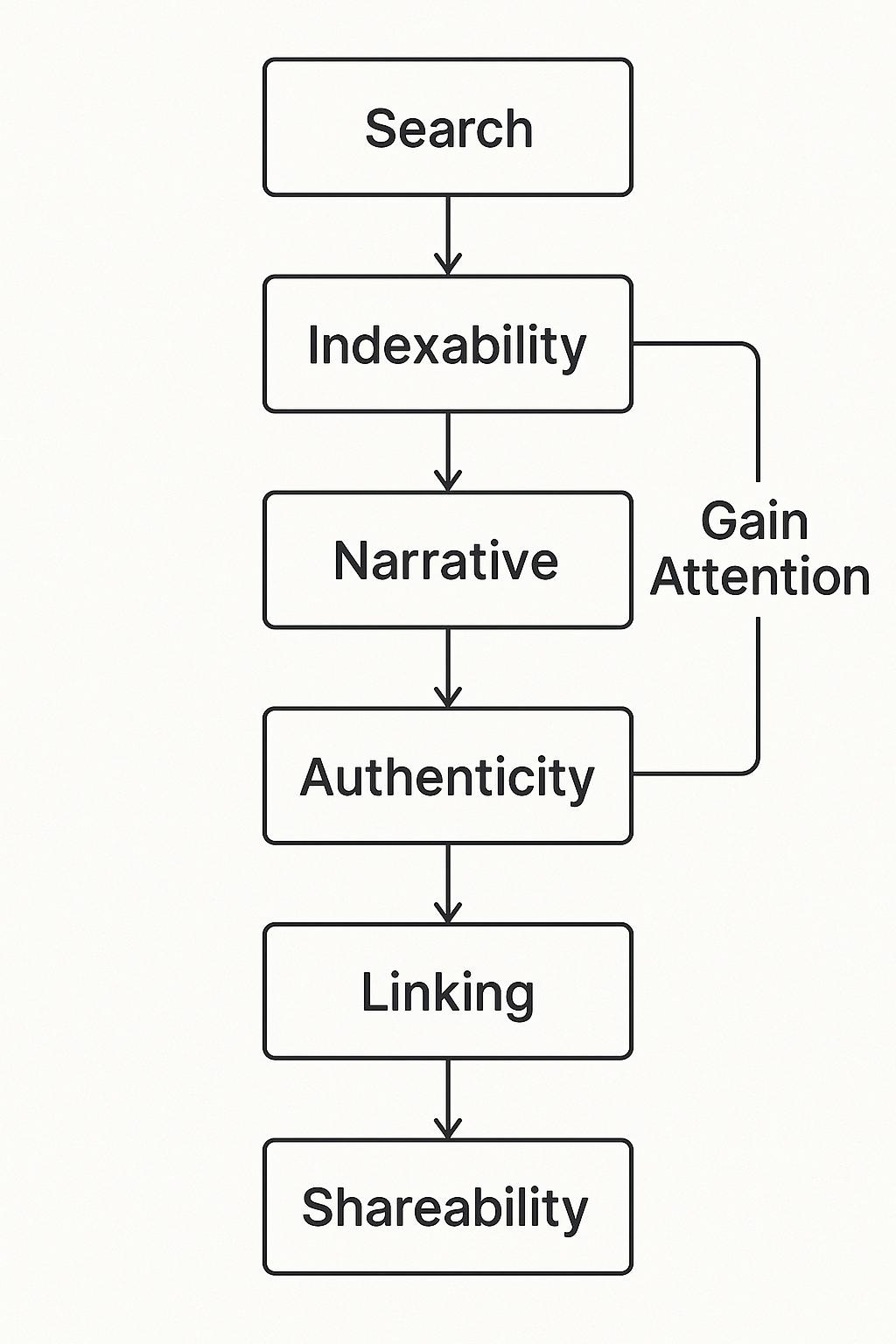The SIGNAL(S) Framework
The only framework you need to plan, execute, and scale your income — faster and smarter.
If this is the first article of mine you’re reading — welcome!
In previous pieces, I’ve broken down each element of the SIGNAL(S) Framework individually.
Today, I’m pulling it all together.
If you’ve ever wondered how some creators seem to effortlessly explode with engagement, followers, and opportunities — this is the framework they’re (knowingly or unknowingly) using.
Below, you’ll find the fastest, smartest way to plan, execute, and scale your income — through content that cuts through the noise.
No guesswork. No burnout. No "hope marketing."
I’ll link out to the deep dives in each section so you can see exactly how the pieces fit together — and how this system has helped me (and can help you) scale faster and more sustainably.
Because here’s the truth:
No strategy = No real plan.
No plan = No real execution.
No execution = No real growth.
Publishing without a plan isn’t bold — it’s blind.
That’s why the SIGNAL(S) Framework exists.
And once you apply it, your content won’t just add noise.
It will multiply your impact.
If you’re serious about growing with strategy, not guesswork, now’s the time.
→ Unlock everything for $24/year. Launch pricing ends soon.
S: Search (Search Intent)
If you’re writing without direction, purpose, or an end-goal, you’re just shooting in the dark.
One day it’s a poem. The next, a business article. No matter how good the writing is — it feels chaotic, and you’ll lose your audience’s attention and trust.
Testing is fine — but even testing needs structure.
Before you create anything, you need to answer two simple questions:
👉 What are people searching for in your niche?
👉 Why are they searching for it?
Only then can you start crafting content that answers their questions, solves their problems, and helps them reach their goals — while positioning you as the obvious guide.
I: Indexability
If you’re just blindly writing content without understanding the platform you’re publishing on, you’re going to find out — pretty quickly — that your content doesn’t surface the way you want it to.
On Substack, you’ve basically got two options:
Option 1:
Write like it’s a traditional blog — meaning you structure your posts to rank on Google (and other search engines).
This is the SEO path.
You’ll need to think about headlines, keywords, formatting, linking — all the unsexy-but-important stuff that makes search engines notice you.
Upside: You can pull in readers from outside Substack.
Downside: You might have to tweak how you naturally write to fit what SEO likes.
Option 2:
Write purely for Substack’s internal algorithm — no SEO, no keyword worries.
Just publishing freely and letting the platform do its thing (kind of… more on that in a bit).
Upside: Way easier to write exactly what you want, the way you want.
Downside: You’re playing by Substack’s discovery rules… and it’s not as simple as "write a post and they will come."
Big thing most people don’t realize:
👉 Posts don’t automatically show up for new readers unless they already follow or subscribe to you, or search and find you manually.
👉 But Notes do show up in people's feeds — even if they don't subscribe or follow you.
That little difference matters — a lot.
Example:
One single Substack Note I recently posted led to 39 new free subscribers, 2 new followers, 798 clicks, 3 shares and a couple hundred comments — without trying to game anything. And it achieved those engagement metrics within roughly 2-3 days.
Bottom line:
Whether you’re trying to rank on Google, grow inside Substack, or do both — you have to be intentional about how your content (and which content) gets indexed.
Otherwise, you’re just hitting publish and hoping for the best.
(FYI: That’s a terrible strategy. Don’t do that.)
Ask yourself:
👉 Are you writing for Substack only?
👉 Are you trying to build search traffic too?
👉 How are you making sure new potential subscribers actually find you?
I’ll give you more distribution and indexing options later under L: Linking — so keep reading.
G: Gain Attention
It doesn’t matter how often you show up — if nobody clicks to read your article, it’s dead on arrival.
How do you fix that?
You gain their attention — fast.
It’s called Stopping The Scroll.
Every platform rewards that initial engagement. Every platform quietly punishes you if you don’t get it. And that includes calculating how many people see your content and do (or do not) click through to read it when they see it.
Here’s why:
Google’s Reason:
Google needs to deliver the most valuable content based on what users search for.
If they get it wrong too often, users will go elsewhere.
Google looks at signals like:
Did people click your article, or skip it? (Skipping suggests your headline doesn't match the search intent.)
Did people stay and read, or bounce back to search? (Bouncing suggests your content didn’t deliver.)
Did people re-search the same query after reading your post? (Meaning you didn’t answer their question.)
Enough bad signals? Your rankings drop — no matter how good your post felt when you published it.
Substack’s Reason:
Substack is playing a different game. Their whole model is about building community, not just serving up answers.
If people see your post or Note in their feed but they don't click through, don't read it, don't share it, don't comment, don't like, or don't restack, it sends a clear signal:
👉 Maybe your content isn’t worth recommending.
(that sounds harsh, but that’s the reality of any algorithm)
And if it’s not helping build connections between readers — no community, no network effect — Substack’s not going to promote it.
The unemotional algorithm will quietly let your post (or Note) fade into obscurity while lifting up the content that does spark conversation, relationships, and growth.
Lesson:
Learn how to grab attention on purpose — don't leave it up to chance.
N: Narrative
Getting attention is just the start.
Keeping it is where narrative comes in.
Your content needs to be structured to hold your reader's attention — start to finish.
If people drop off too early, that’s considered a bounce.
(Basically: they didn’t find your article helpful, entertaining, or educational.)
Again, all platforms care about this:
Google: Bounce rates hurt your ranking.
Substack: No engagement, no growth.
A strong narrative makes your content "sticky."
It pulls people deeper, keeps them reading, and builds enough trust to make them want to read your next piece too.
A: Authenticity and Authority
Right now, the internet is filling up with recycled, stale, AI-generated content faster than ever.
If you want your signal to break through the noise, you need two things:
Authenticity — Your real voice, your real stories, your real insights.
Authority — Showing people you know what you're talking about because you've lived it, not just Googled it.
Readers (and algorithms) can feel the difference.
Surface-level content might get quick views. But deep, authentic, authoritative content earns loyalty, which in turn earns engagement.
L: Linking
Publishing without linking is like building roads that lead nowhere.
You need to build links in a way that makes sense.
Here’s the three types you need:
1. Internal Linking:
Connect your own content together. You’ll notice in this article that I’ve linked to all of my other related articles for each of these elements of the SIGNAL(S) Framework. That’s by design–it’s intentional internal linking.
It helps readers go deeper.
It helps Google and Substack map your expertise.
It keeps people on your pages longer, and engaging with even more of your content as opposed to the single article they read initially.
Pro Tip:
👉 Every post you publish should link to at least one other post — and have at least one post linking into it.
2. External Linking (Inbound Links):
When others link to you, it’s SEO rocket fuel. It’s also Substack growth fuel, because now people will naturally find you while reading other creators content.
It’s no longer growth through addition – it’s growth through multiplication.
How do you do that?
You build relationships.
You write guest posts.
You collaborate.
You network and establish Substack cross-recommendations.
3. Ecosystem Linking:
Connect your whole content world:

Substack → Social Profiles (if relevant)
Social profiles/posts → Articles (if relevant)
Articles → Notes
Notes → Articles → Interviews
Notes → Articles → Products/Services
Articles → Subscription Pages
Newsletters → Upsells/Cross-Sells/Downsells
Purchases → Workflows → Articles/Products/Services
Think of it like weaving a network of radio towers.
The stronger and more connected your network, the harder it is for people to lose your signal — and the easier it is for platforms to keep boosting you.
Content without connections is content that gets lost.
Build an ecosystem – and your audience will always find their way back to you.
Time and time again.
S: Shareability
If people aren’t sharing and re-stacking your content, it’s going to have a very hard ceiling on how far it can spread — no matter how good it is.
Remember:
👉 Engagement drives visibility.
👉 Visibility drives growth.
And shares are a super-powered form of engagement.
When someone shares your content, they're basically telling their own audience:
"Hey, this is good. You should check it out."
It’s a credibility boost and an organic distribution channel — all for free.
How to increase Shareability:
Write for emotions, not just facts.
People share what makes them feel something — inspired, smarter, validated, understood.Make sharing easy.
Create quotable moments, easy pull-quotes, strong one-liners, and eye-catching visuals.Package ideas cleanly.
A messy, complicated post? People will say “cool” — and move on.
A sharp, tight post? They’ll think, “This is worth showing someone.”Earn the first share.
The fastest way to get multiple shares?
You share first. And include the "ask" when you create your own content.
You don’t need years to master content that resonates.
With VTG 2.0, you’ll quickly create writing that inspires, validates, educates — and deeply connects.
⚡ Final Word:
If you don’t control your signal, the noise will control your growth.
The SIGNAL(S) Framework isn’t just theory.
It’s a simple, actionable system for making your content more discoverable, more clickable, more engaging — and way more powerful.
When you build your content this way, you’re not just publishing.
Your moving from growth through addition to growth through multiplication.
Ready to put the SIGNAL(S) Framework into play?
Start with the next piece you write.
Because if you can master your signal, you can scale anything.















I love these tips! Incorporating them all. Thank you! ❤️